Like Father, Like Son
/No words needed.
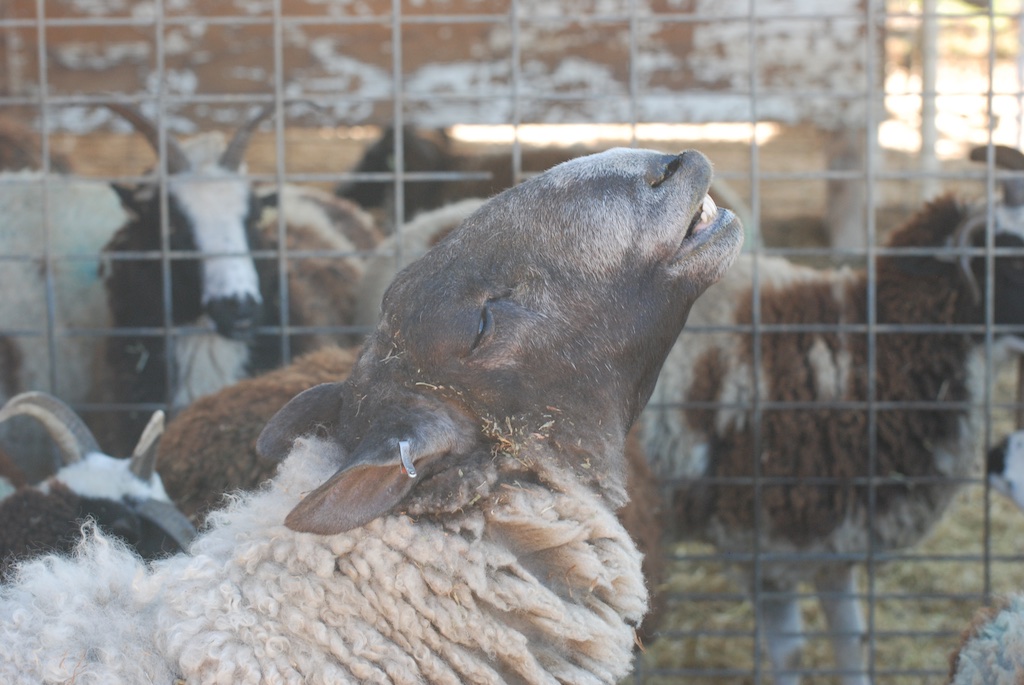
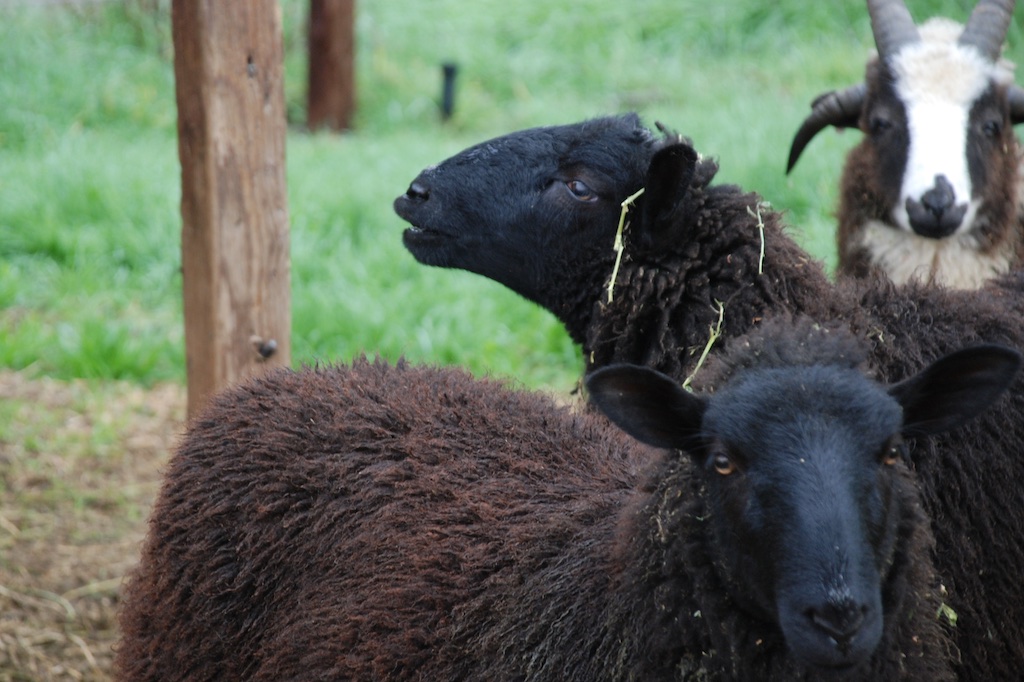
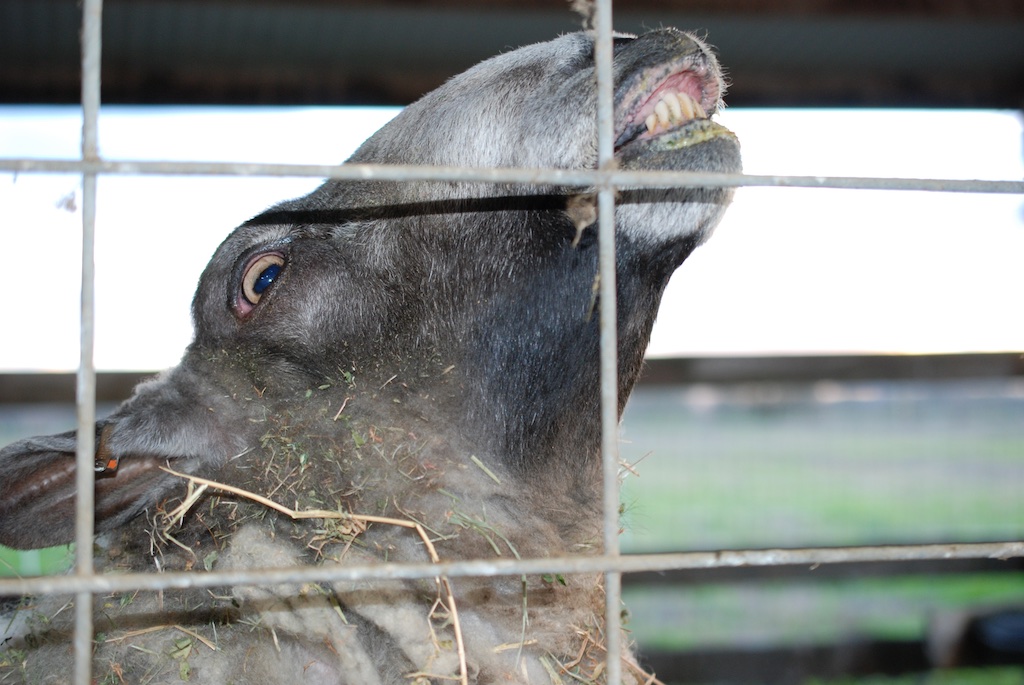
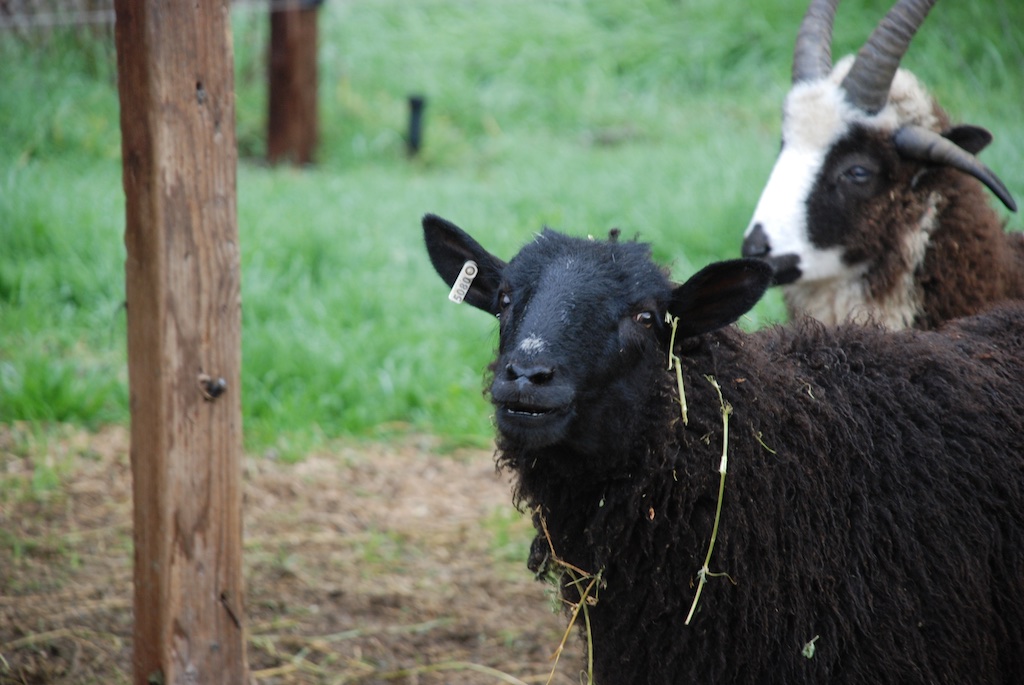
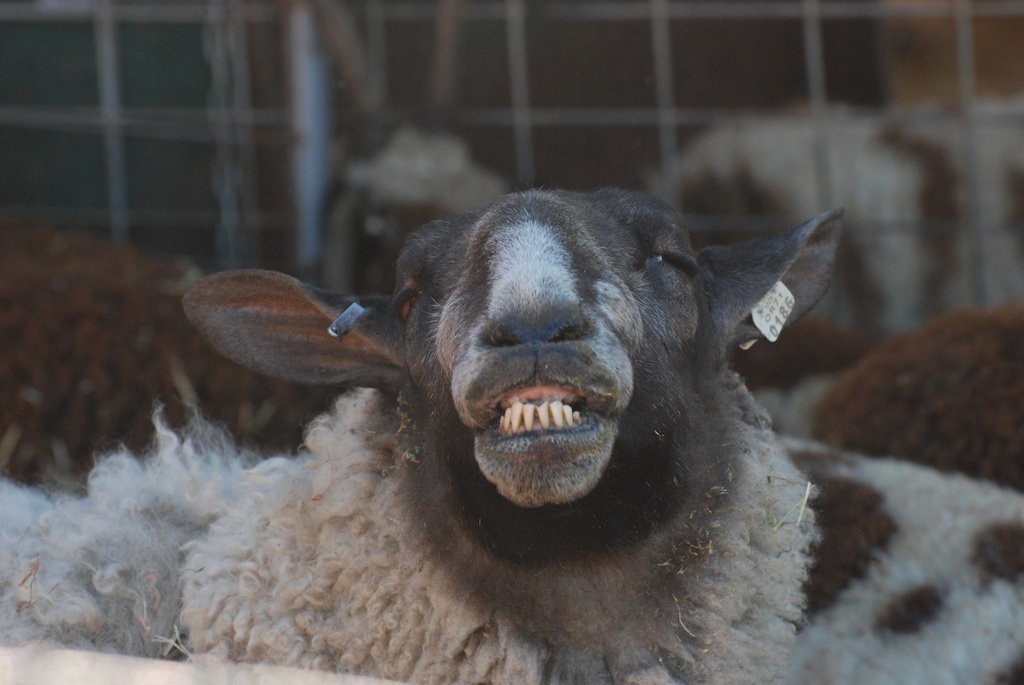
No words needed.





The sheep are now separated into only two flocks now. There is a smaller non-breeding group and the larger group of ewes who are all (hopefully) bred. A couple of days ago I put the young rams, Nash and Rotor back together and their ewes with the rest of the flock.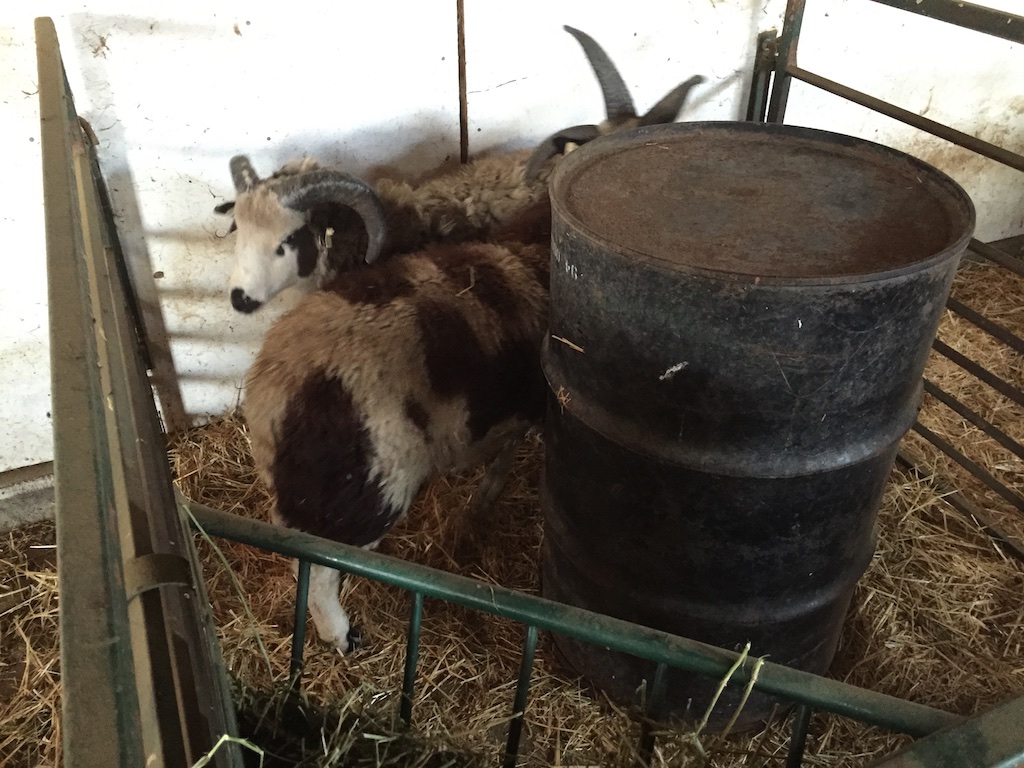 The trick with putting rams together is to crowd them into a small space until they have figured out the pecking order. They will still fight but can't do as much damage as if they had more room to bash each other. This was too much room even with the barrel taking up space. Rotor, the 4-horn ram was beating the heck out of Nash, the 2-horn. Nash is the bigger ram so it surprised me that Rotor was the dominant one.
The trick with putting rams together is to crowd them into a small space until they have figured out the pecking order. They will still fight but can't do as much damage as if they had more room to bash each other. This was too much room even with the barrel taking up space. Rotor, the 4-horn ram was beating the heck out of Nash, the 2-horn. Nash is the bigger ram so it surprised me that Rotor was the dominant one.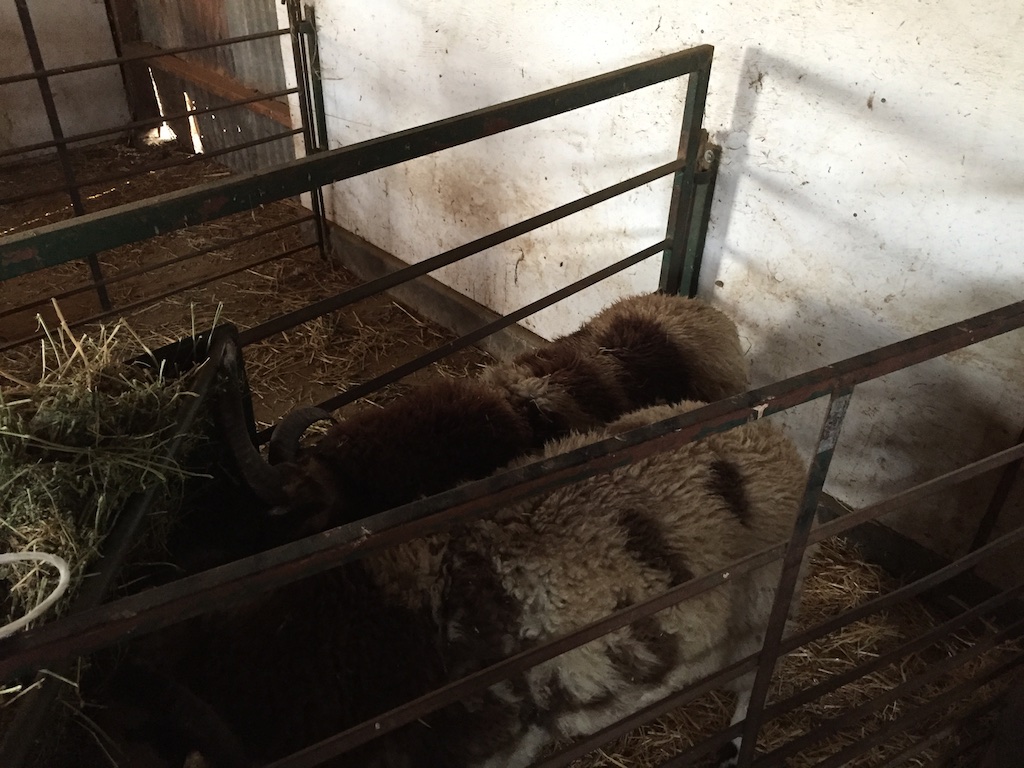 They spent the night in this space and I took out the middle panel the next morning.
They spent the night in this space and I took out the middle panel the next morning.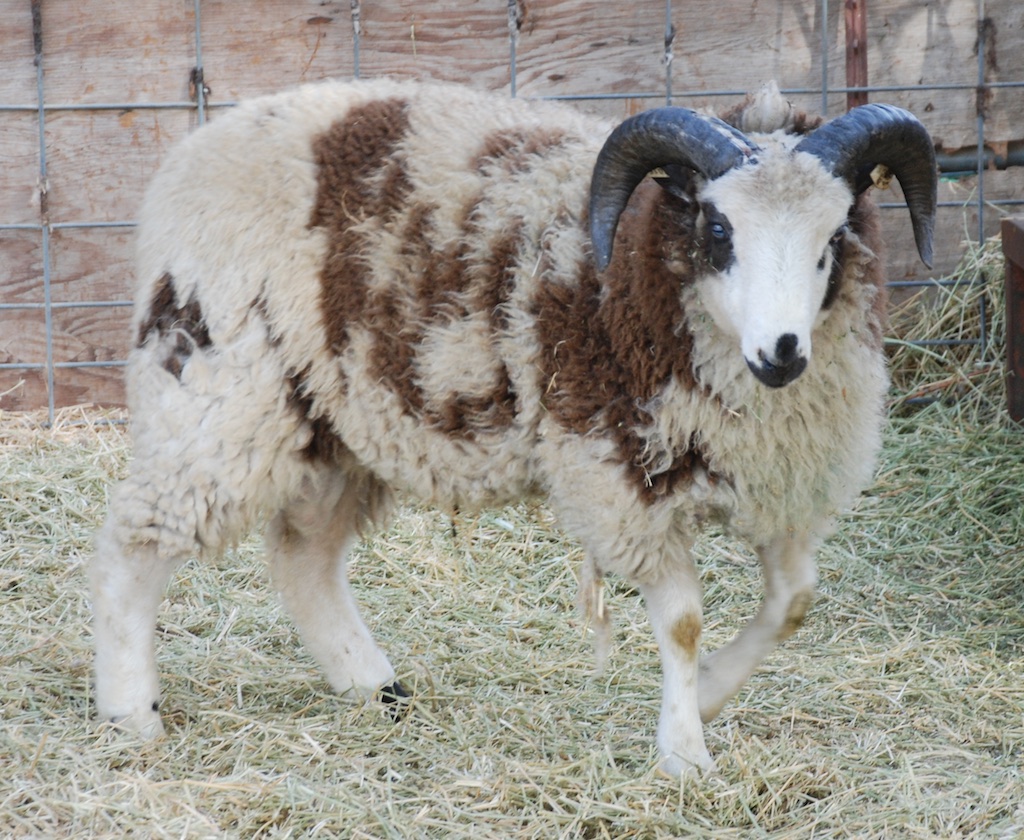 Now they are back in the ram pen and best buddies. This is one of the photos I will send in for Nash's registration.
Now they are back in the ram pen and best buddies. This is one of the photos I will send in for Nash's registration.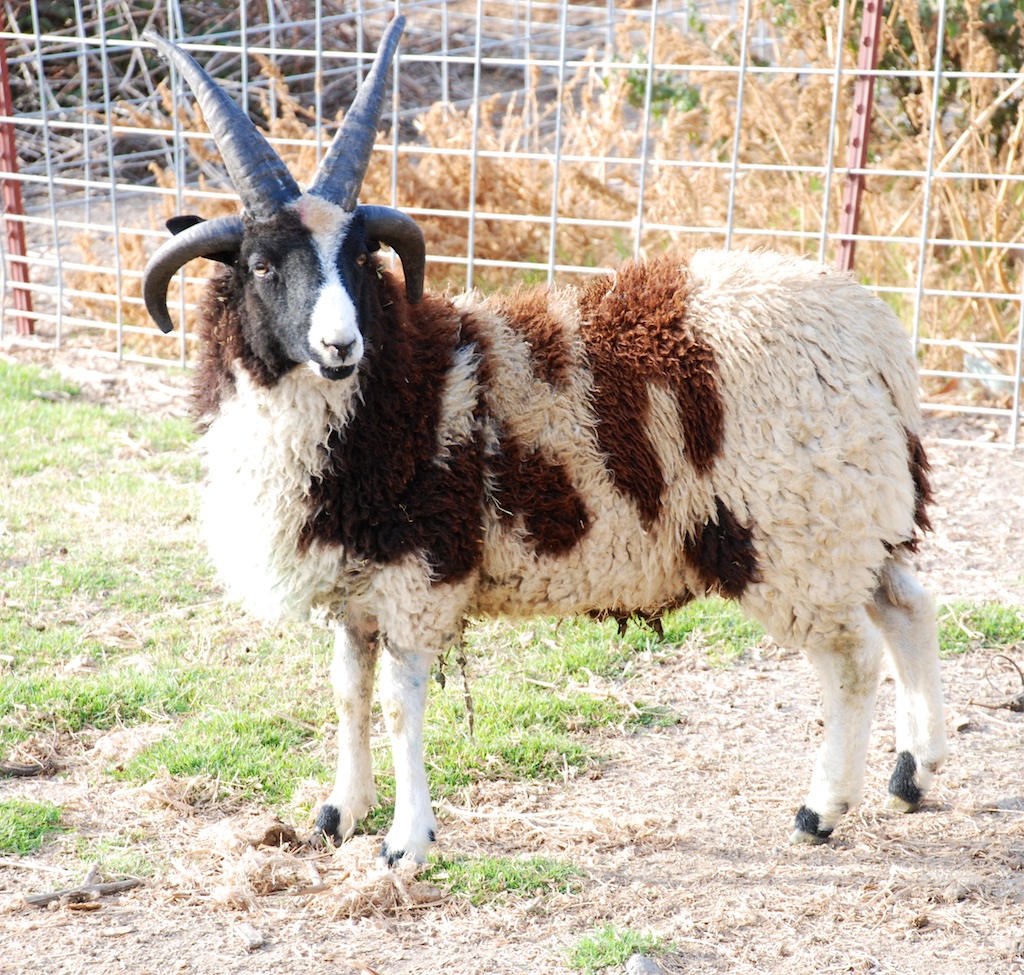 This is Rotor. Both are only 7 months old.
This is Rotor. Both are only 7 months old. Another March lamb I will register is Honey.
Another March lamb I will register is Honey. 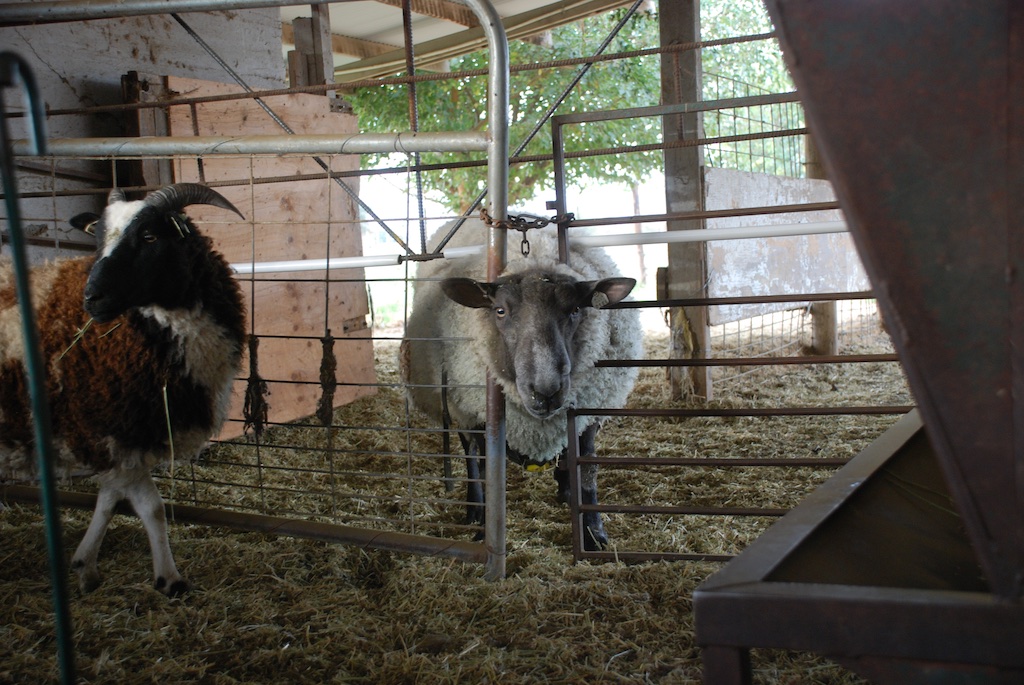 After I sent Ringo off to a friend's farm (when he comes back I'll have to go through ram introduction all over again) the ewes were in the barn near Faulkner. Is this wishful thinking on his part?
After I sent Ringo off to a friend's farm (when he comes back I'll have to go through ram introduction all over again) the ewes were in the barn near Faulkner. Is this wishful thinking on his part?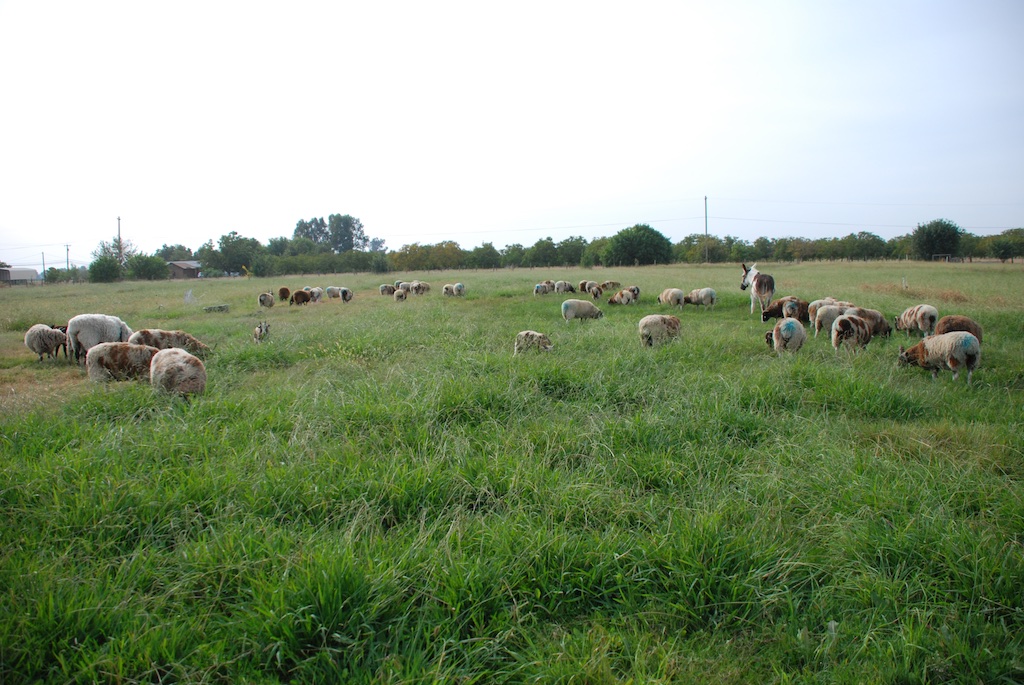 I sent him out to the field with all the ewes.
I sent him out to the field with all the ewes. He found at least one ewe who was interested in him.
He found at least one ewe who was interested in him.
Not a very good title... and it doesn't describe what I want to share in this post, but dental surgery was the event on Monday that set the tone for the week.
I stayed on the codeine less than 24 hours because I don't like feeling so...well, drugged. I didn't feel too bad on Wednesday and some Farm Club friends came to help me set up breeding groups. It is always a challenge to find enough places to put the groups where there is no fence-line contact between rams.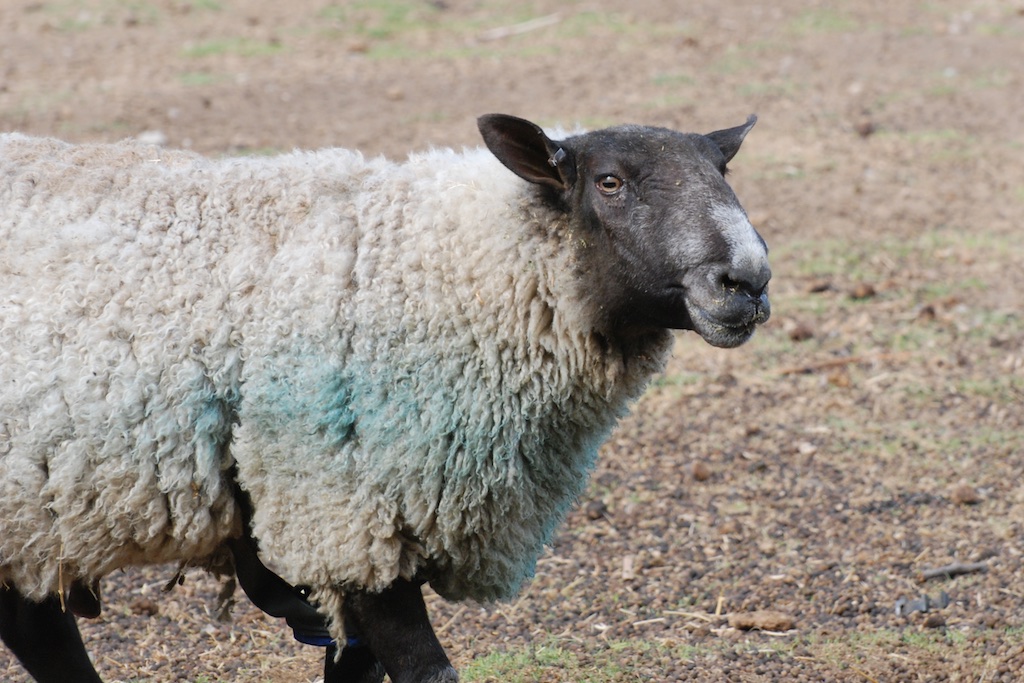 I left Faulkner in his area but expanded it to include the run next to it.
I left Faulkner in his area but expanded it to include the run next to it.
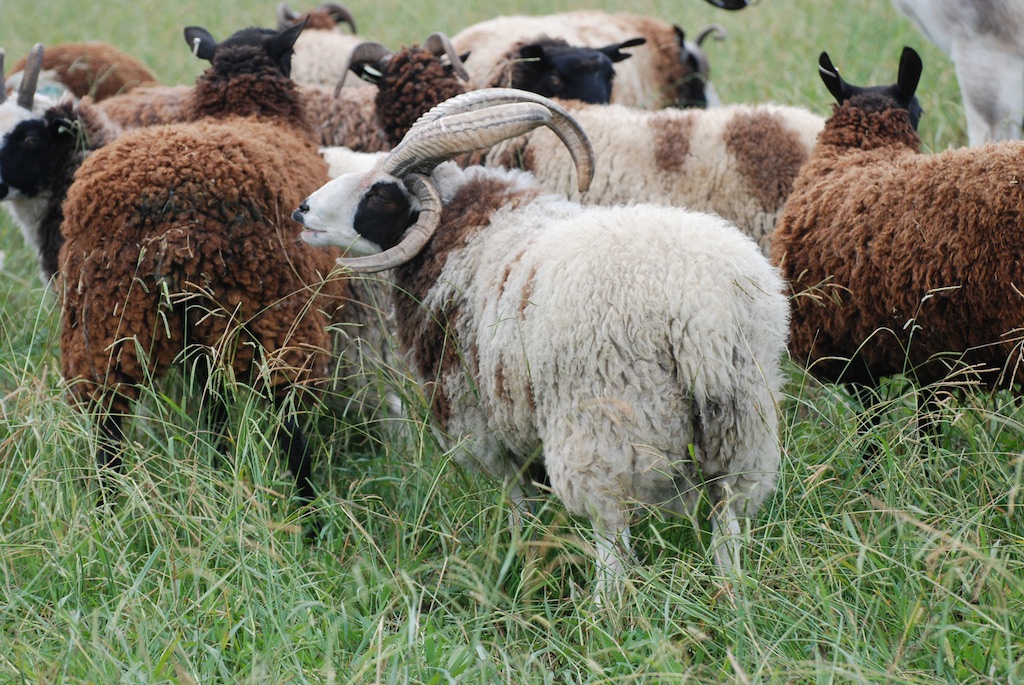 Ringo got the most ewes so he had the pasture.
Ringo got the most ewes so he had the pasture.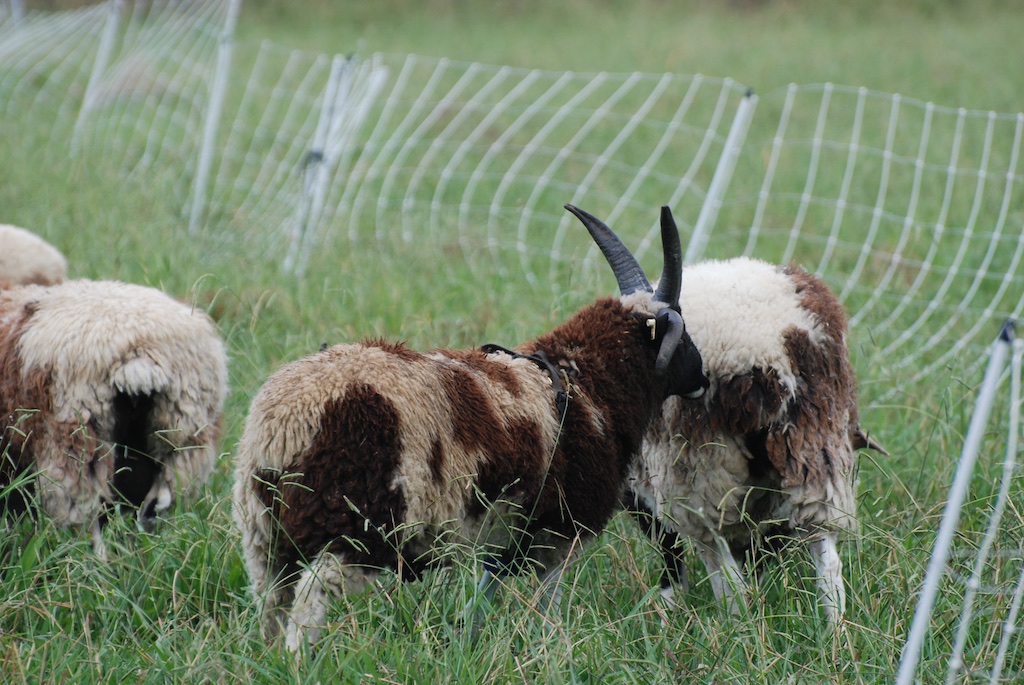 Rotor, one of the lambs born in March, went with his ewes to the horse pasture. We wondered if he'd be able to reach those ewes, but he's had no problem. I don't have a photo of Nash, the lilac ram. He went to the field behind the shop. Crosby and Alex were left in the ram pen.
Rotor, one of the lambs born in March, went with his ewes to the horse pasture. We wondered if he'd be able to reach those ewes, but he's had no problem. I don't have a photo of Nash, the lilac ram. He went to the field behind the shop. Crosby and Alex were left in the ram pen.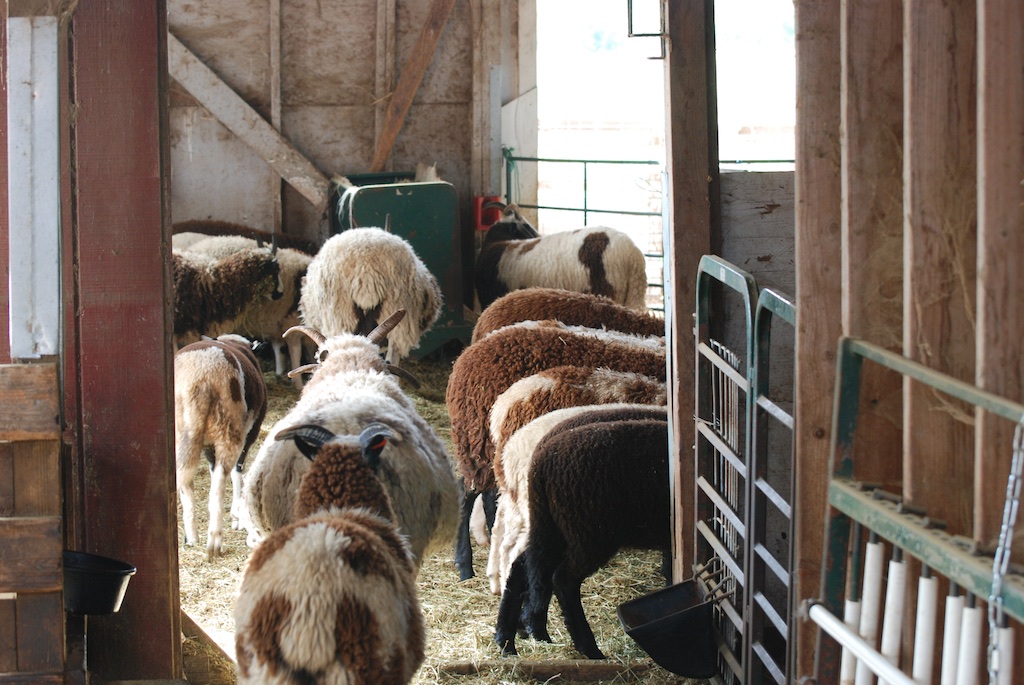 The non-breeding group includes the ewes to be bred in February for lambing at the State Fair, their lambs, some of the ewe lambs that I'm keeping, other ewe lambs for sale, and this year 4 ewe lambs that are sold but haven't left yet. It's a lot of sheep to keep away from the rams but I barricaded them in the area around the barn.
The non-breeding group includes the ewes to be bred in February for lambing at the State Fair, their lambs, some of the ewe lambs that I'm keeping, other ewe lambs for sale, and this year 4 ewe lambs that are sold but haven't left yet. It's a lot of sheep to keep away from the rams but I barricaded them in the area around the barn.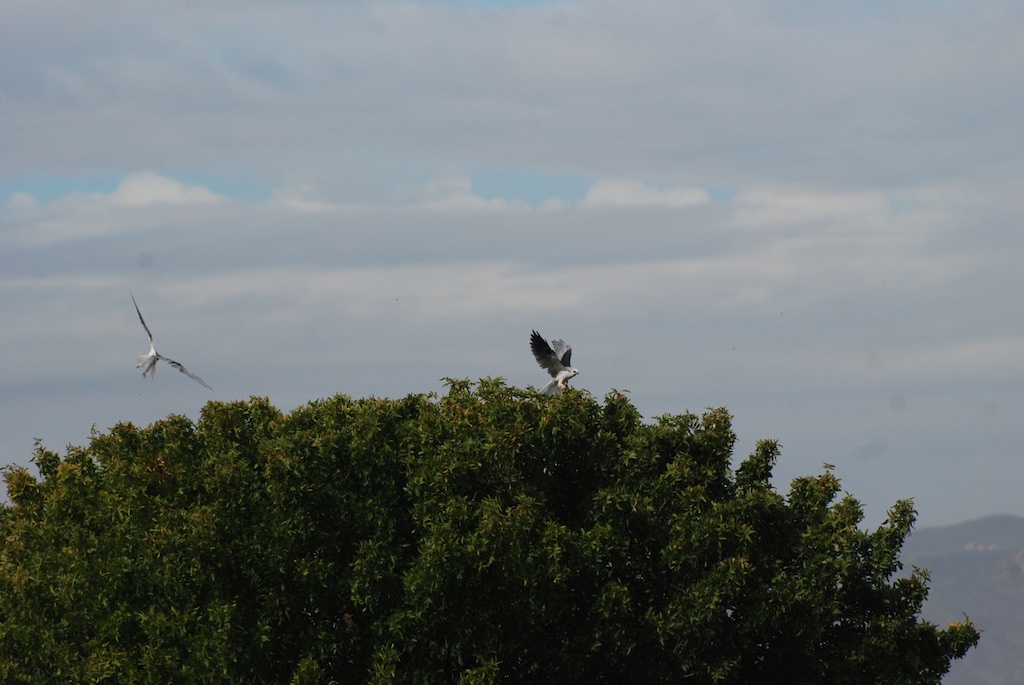 Our resident white-tailed kites, seen from the barn.
Our resident white-tailed kites, seen from the barn.
One of the adult rams, Alex, was picked up by his new owner on Thursday so I put the few remaining ram lambs with Crosby to keep him company for the day. On Friday I took 7 sheep, including Crosby, Nash, and Rotor to Lambtown for the sheep show on Sunday. Normally I am a vendor at Lambtown but this year there was a conflict with an event I had really wanted to attend and where I knew that I'd sell well. So I took sheep for the weekend but attended Fibershed on Saturday. It's a good thing. I probably should have stayed home entirely but at least the Fibershed event was easier than doing a full vendor booth at Lambtown.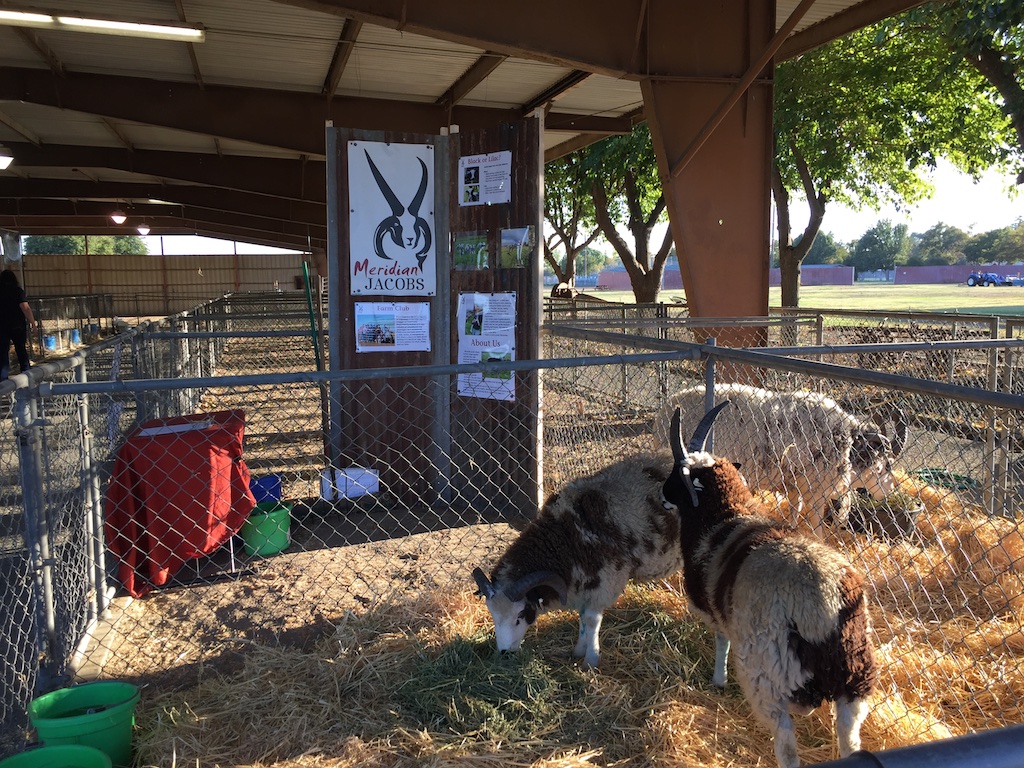 Here are two of the sheep pens at Lambtown and my meager display.
Here are two of the sheep pens at Lambtown and my meager display.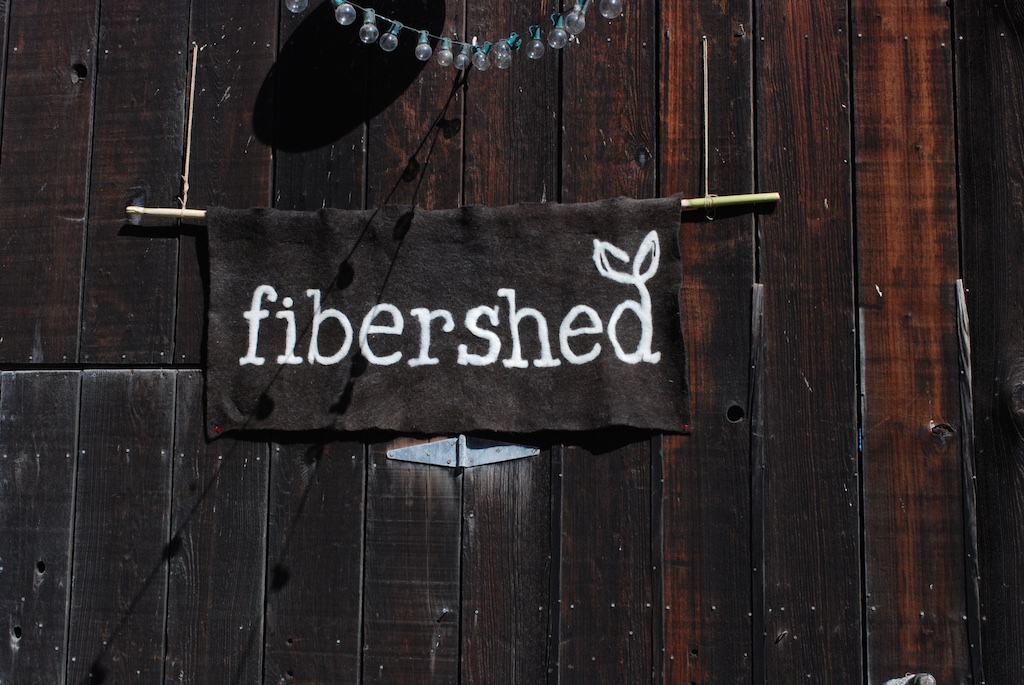 Saturday was the Grow Your Jeans event that was the culmination of over a year's planning and work by the Fibershed team. There are photos and a description of the work involved in growing cotton and indigo in the nearby Capay Valley and the dyeing, weaving, and pattern-making of these locally produced jeans at this link. The Grow Your Jeans event featured these jeans as well as "grass-fed tops", the shirts and accessories worn with them on the straw-bale fashion show runway. The new felt banner was made by FC friend, Jackie, of Sheep to Shop.
Saturday was the Grow Your Jeans event that was the culmination of over a year's planning and work by the Fibershed team. There are photos and a description of the work involved in growing cotton and indigo in the nearby Capay Valley and the dyeing, weaving, and pattern-making of these locally produced jeans at this link. The Grow Your Jeans event featured these jeans as well as "grass-fed tops", the shirts and accessories worn with them on the straw-bale fashion show runway. The new felt banner was made by FC friend, Jackie, of Sheep to Shop.
Prior to the fashion show attendees could shop at the vendor booths and eat fabulous local food. (At least it looked fabulous. I stuck to my yogurt and cottage cheese.) I brought handwoven pieces, horn buttons, and lambskins. I did very well as far as sales, but, unfortunately by this point, I was not in the best of shape. I just wanted to be home on the couch.
I brought handwoven pieces, horn buttons, and lambskins. I did very well as far as sales, but, unfortunately by this point, I was not in the best of shape. I just wanted to be home on the couch. 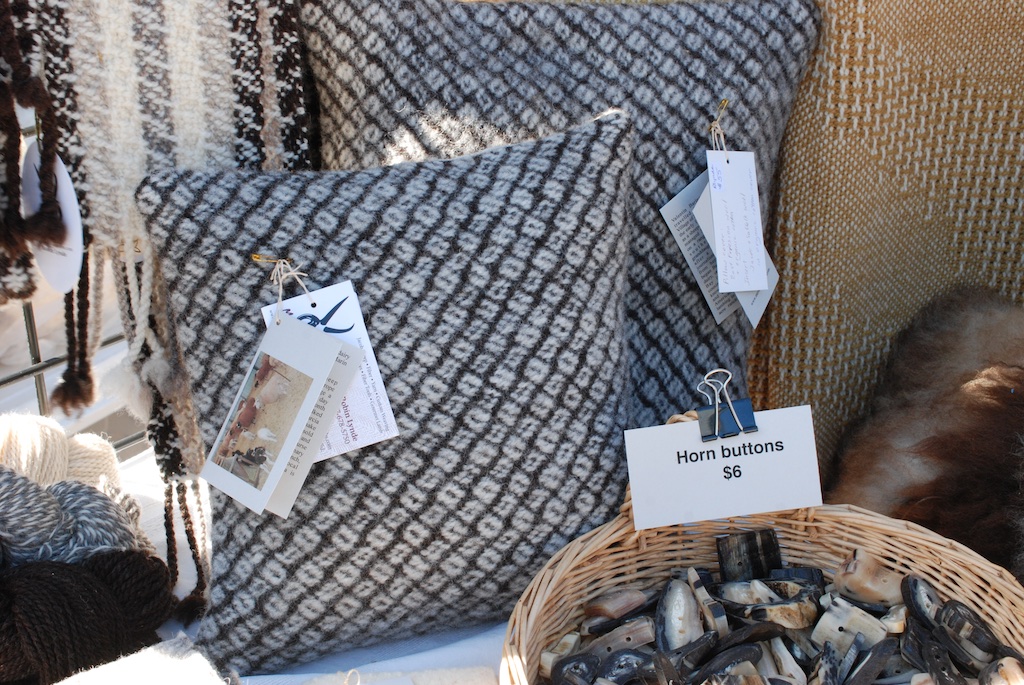 These pillows are stuffed with local wool in an cover of organic cotton. They both sold.
These pillows are stuffed with local wool in an cover of organic cotton. They both sold. This is my "grass-fed top" on the left. It is Timm Ranch wool woven in 16-shaft huck lace. The weft is dyed with osage orange from across the road.
This is my "grass-fed top" on the left. It is Timm Ranch wool woven in 16-shaft huck lace. The weft is dyed with osage orange from across the road.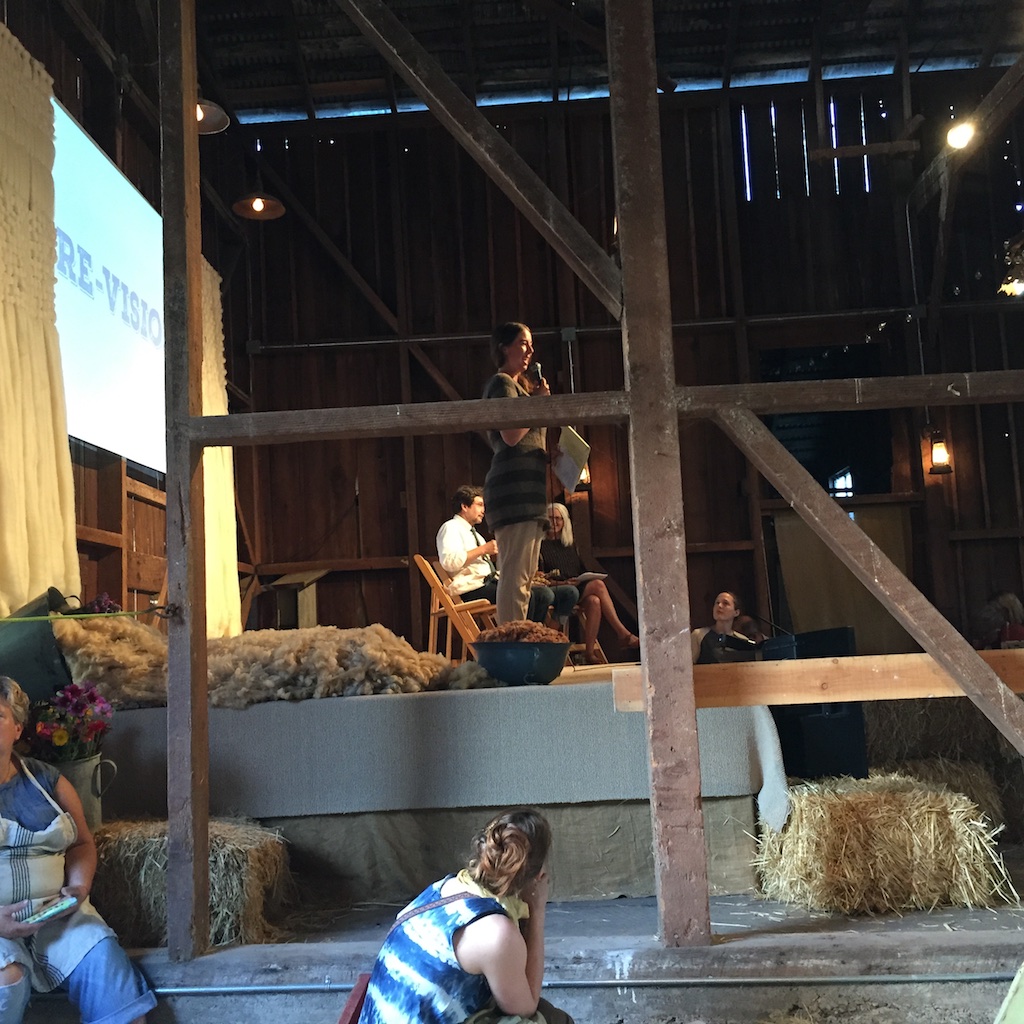 The fashion show took place in an old dairy barn. Prior to the show, Rebecca and the others involved in creating the jeans told about their parts in the project.
The fashion show took place in an old dairy barn. Prior to the show, Rebecca and the others involved in creating the jeans told about their parts in the project.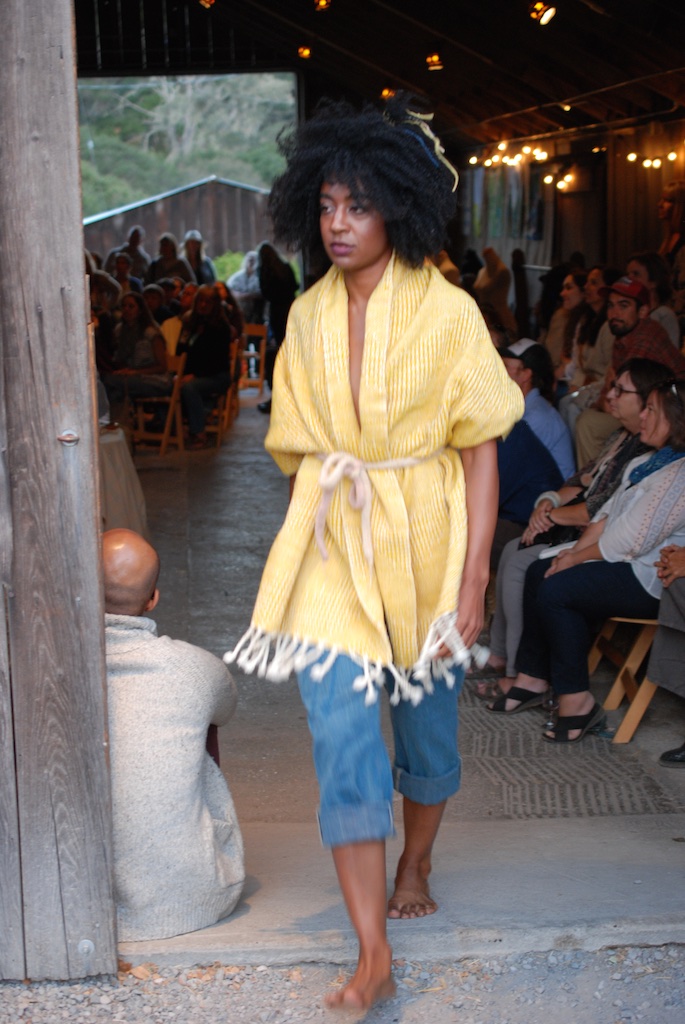 I stood just outside to get a photo of the model wearing my shawl.
I stood just outside to get a photo of the model wearing my shawl. I stepped back inside to see the last part of the show. Two of the models came out carrying this flag.
I stepped back inside to see the last part of the show. Two of the models came out carrying this flag.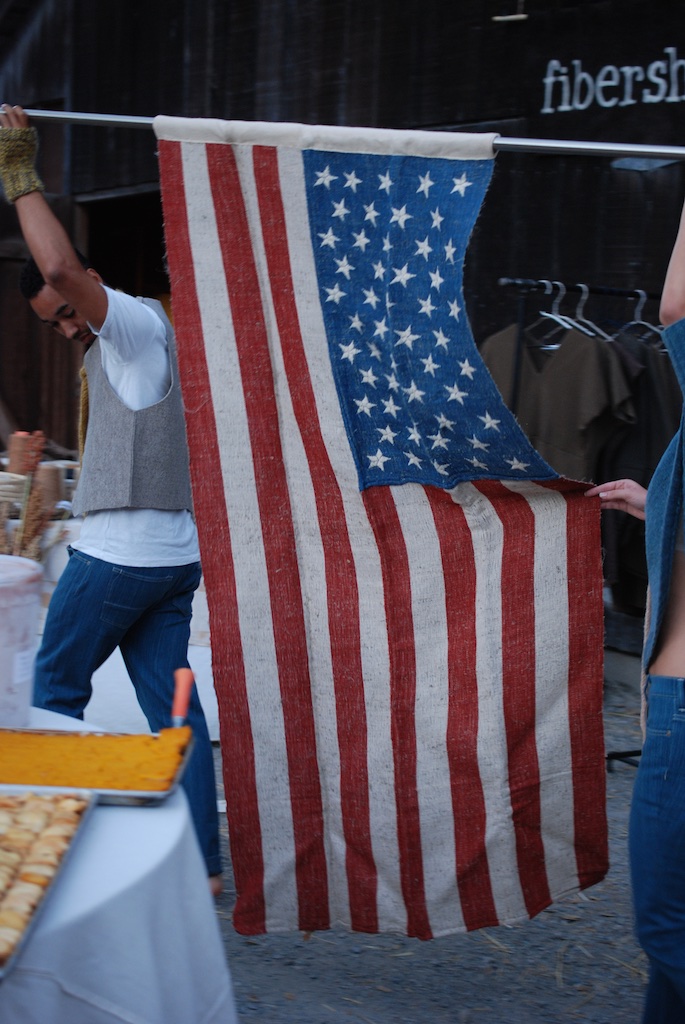 Along with all of the other aspects of Fibershed that Rebecca spearheads, she has also been involved with the re-introduction of hemp as a valued agricultural crop in Kentucky. It's a long story and you can read some interesting articles here. This is one of five flags to be woven from the veteran-grown hemp project. They use Sally Fox's California grown cotton for warp and Kentucky hemp for weft. The first flag went to Farm Aid and this is the second one. I thought it was a fabulous way to end the evening's program. Kind of gives you chills.
Along with all of the other aspects of Fibershed that Rebecca spearheads, she has also been involved with the re-introduction of hemp as a valued agricultural crop in Kentucky. It's a long story and you can read some interesting articles here. This is one of five flags to be woven from the veteran-grown hemp project. They use Sally Fox's California grown cotton for warp and Kentucky hemp for weft. The first flag went to Farm Aid and this is the second one. I thought it was a fabulous way to end the evening's program. Kind of gives you chills.
I am not doing justice here to the whole event. Everything that Fibershed puts on is exceedingly well done and the message is so important. I am grateful to be involved in this movement even in a small way.
It was a long drive home to Bolinas that night and then there was still Lambtown the next day. I had a ride to and from so started in on the codeine.  On Saturday Farm Club friends had been on the winning Sheep to Shawl team. This is the fabulous blanket that they spun and wove.
On Saturday Farm Club friends had been on the winning Sheep to Shawl team. This is the fabulous blanket that they spun and wove.
After the sheep show I doubled up on the codeine and waited for my husband to come drive the sheep home.
...wouldn't life be peaceful without them?
The rams were giving me so much trouble with the fence in the pen I'd used for years that we switched them to a new space about six weeks ago. It's been working OK but now breeding season is upon us and they are getting harder to deal with. Welded wire panels alone are not enough. Here is what happens when ewes flaunt themselves just across the fence.
Here is what happens when ewes flaunt themselves just across the fence.  Not only are the rams ruining the panels, but the electric fence on the ewe side is immediately grounded out and that means that all the electric fence on that system is out.
Not only are the rams ruining the panels, but the electric fence on the ewe side is immediately grounded out and that means that all the electric fence on that system is out. 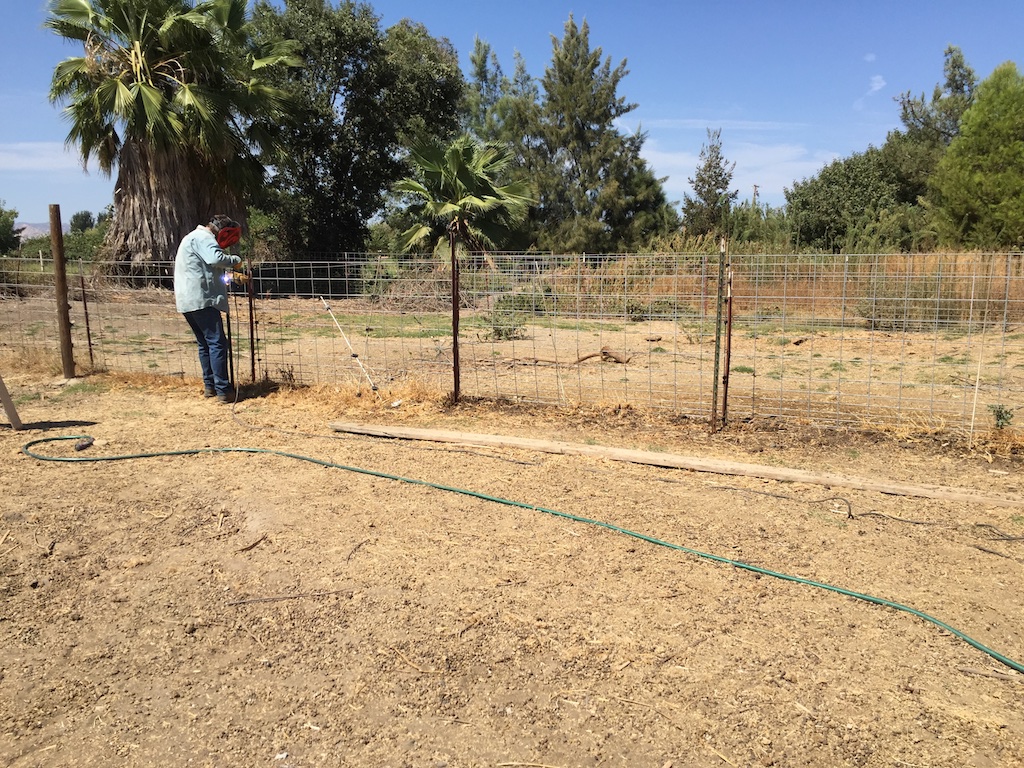 Dan had an idea that would hopefully solve the problem for the short-term in the areas where the rams were pushing on their fence and bending the t-posts.
Dan had an idea that would hopefully solve the problem for the short-term in the areas where the rams were pushing on their fence and bending the t-posts.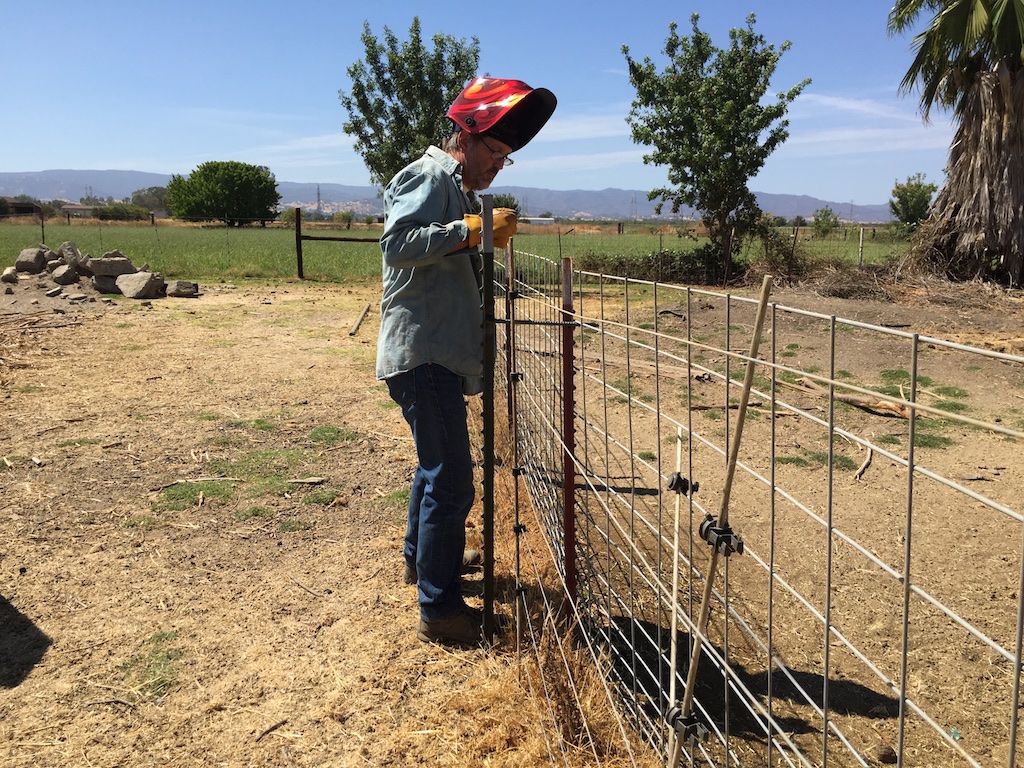 He put in extra posts that we happened to have around and welded rebar between the posts on the two sets of fences to help make things sturdier. We hoped that it would make the whole thing more secure.
He put in extra posts that we happened to have around and welded rebar between the posts on the two sets of fences to help make things sturdier. We hoped that it would make the whole thing more secure.
 Here is what Ginny thought when she noticed the welder in the corral.
Here is what Ginny thought when she noticed the welder in the corral.
 There was a shirt hanging off of it so maybe she thought it was a short person.
There was a shirt hanging off of it so maybe she thought it was a short person.
 Lots of reinforcement should keep them from pushing those t-posts over, right?
Lots of reinforcement should keep them from pushing those t-posts over, right?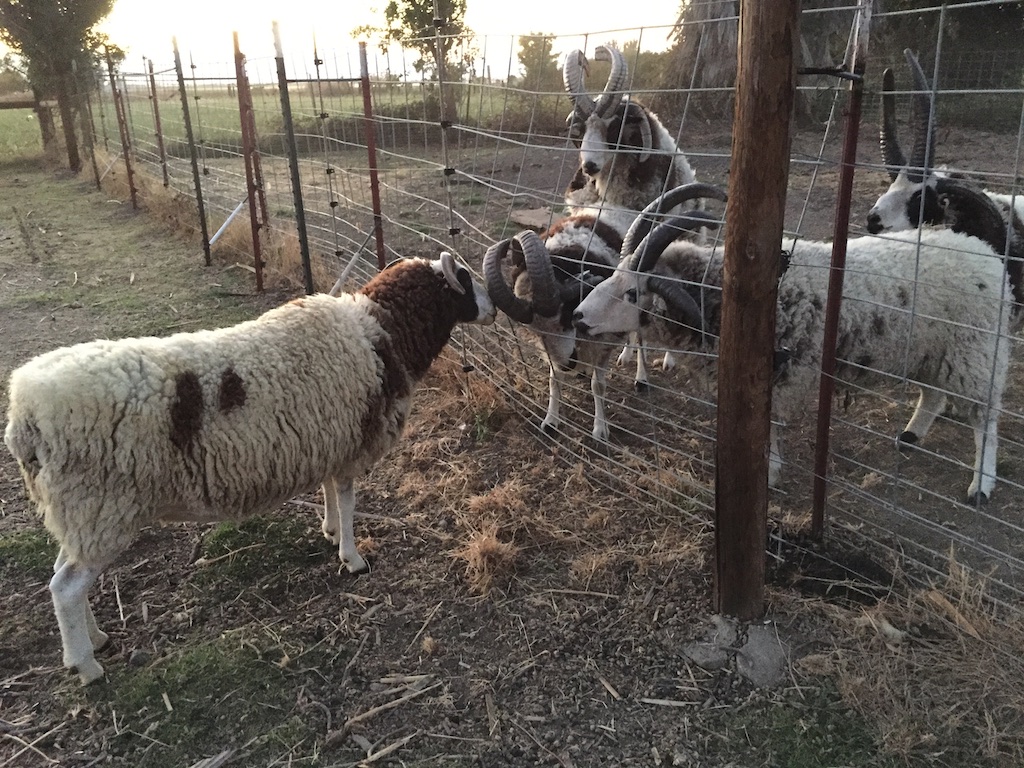 Fence posts look good.
Fence posts look good. 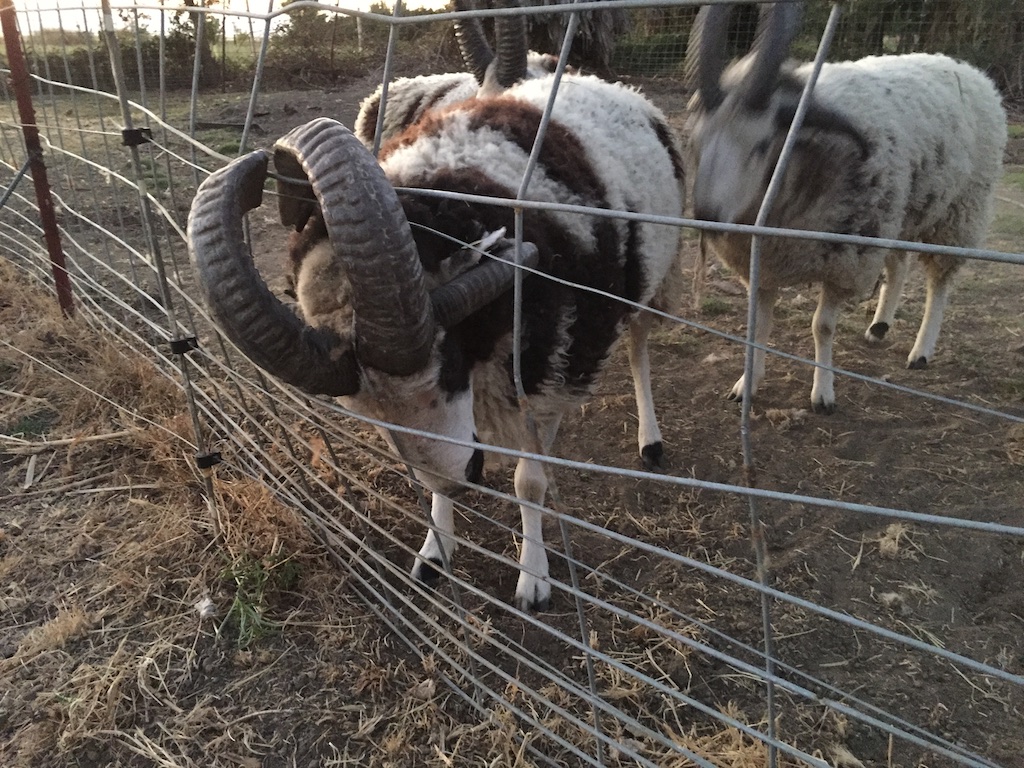 The wire, not so much. He was completely stuck in the welded wire and the high tensile wire. This is Alex, by the way, whose horn I just trimmed in the last post.
The wire, not so much. He was completely stuck in the welded wire and the high tensile wire. This is Alex, by the way, whose horn I just trimmed in the last post.
 The only way to get Alex out of this was to cut the welded wire panel in two places. Now I have the ewes completely separated, but that isn't a long-term solution. Unfortunately I don't have a big enough place to have the rams in a pen that is isolated from everyone else so we'll be moving to Plan C when we have time (that would be when Dan has time).
The only way to get Alex out of this was to cut the welded wire panel in two places. Now I have the ewes completely separated, but that isn't a long-term solution. Unfortunately I don't have a big enough place to have the rams in a pen that is isolated from everyone else so we'll be moving to Plan C when we have time (that would be when Dan has time).
Taken over the last week or so.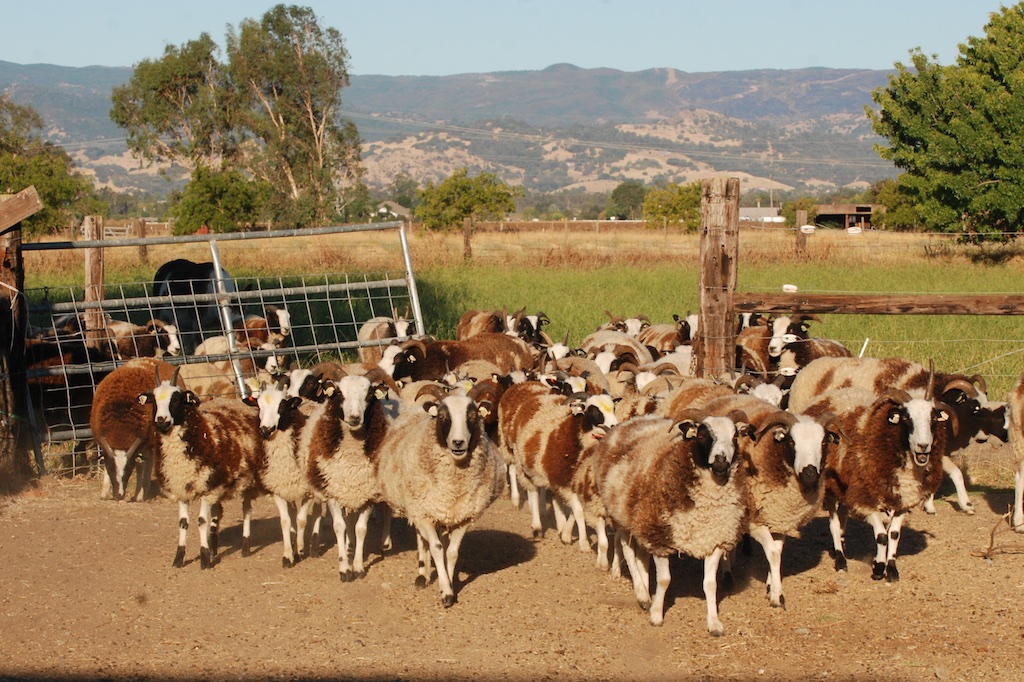 Sheep coming in from the pasture.
Sheep coming in from the pasture.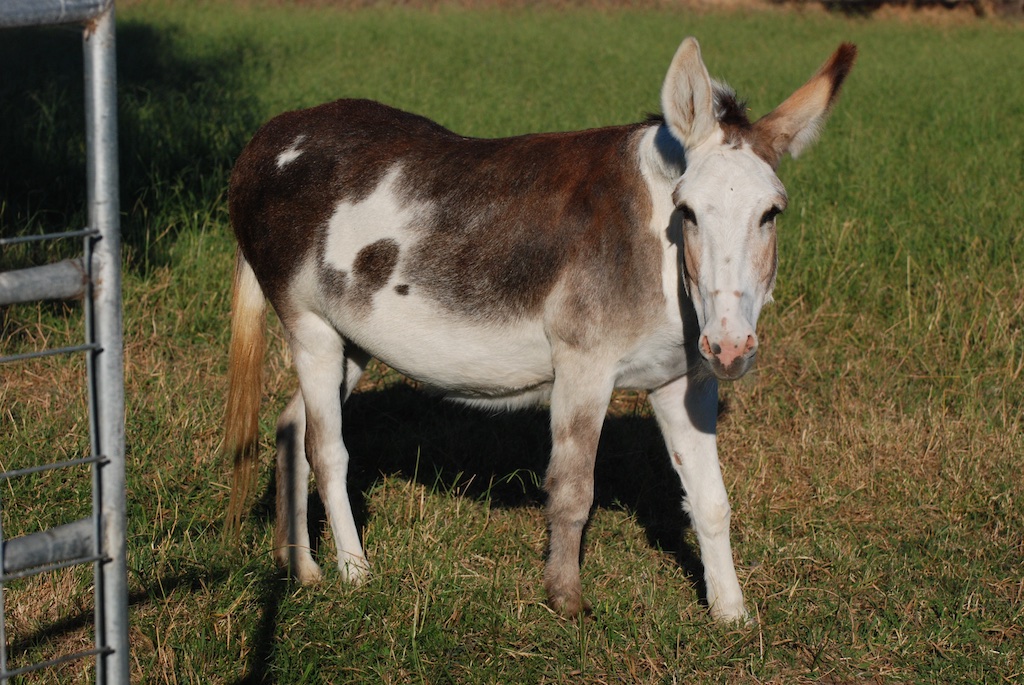 Amaryllis following.
Amaryllis following.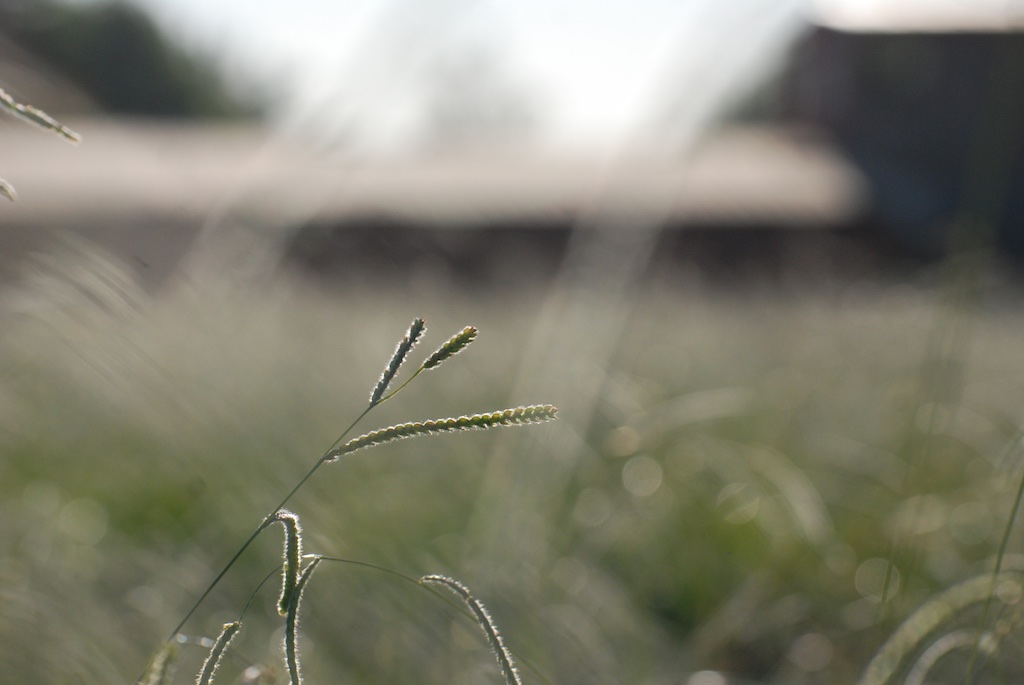 Dallisgrass.
Dallisgrass.
 Ram lamb that I'm keeping. He'll be at the Lambtown sheep show. This is Meridian Nash (Meridian Crosby x Mud Ranch Ginseng).
Ram lamb that I'm keeping. He'll be at the Lambtown sheep show. This is Meridian Nash (Meridian Crosby x Mud Ranch Ginseng).
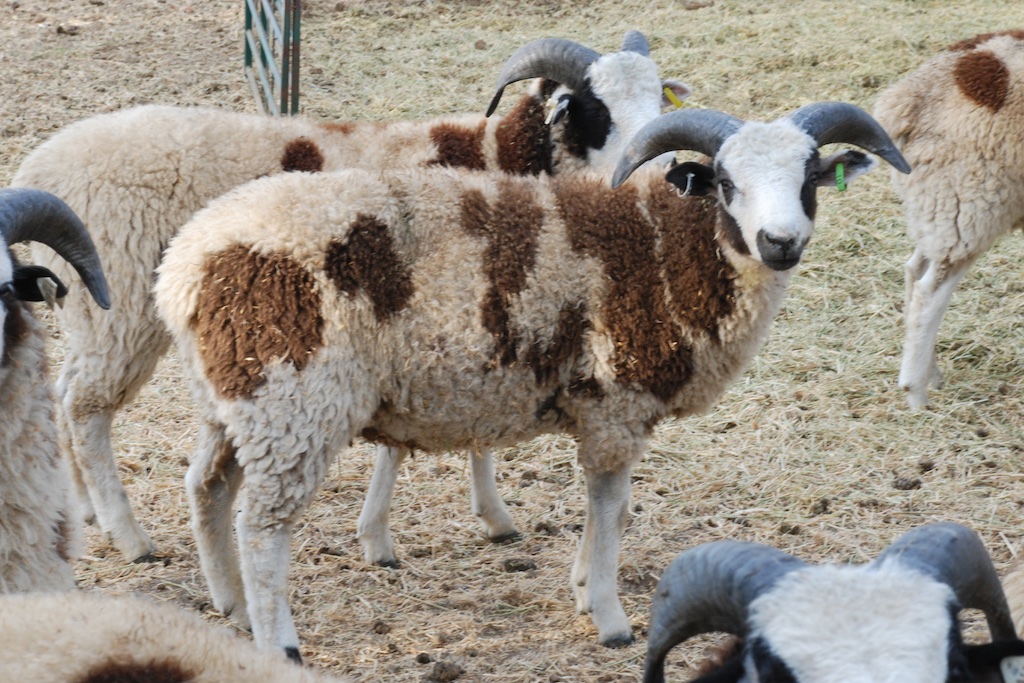 Love this guy's horn spread (Meridian Crosby x Meridian Sophia). I wish I had room to keep all the promising ram lambs for several months, but most have to go before breeding season. In fact there has already been at least one major ram break-out involving the ram lambs and I'm sure that I'll have at least a couple of early lambs (mid January instead of late February when the planned lambs will come).
Love this guy's horn spread (Meridian Crosby x Meridian Sophia). I wish I had room to keep all the promising ram lambs for several months, but most have to go before breeding season. In fact there has already been at least one major ram break-out involving the ram lambs and I'm sure that I'll have at least a couple of early lambs (mid January instead of late February when the planned lambs will come).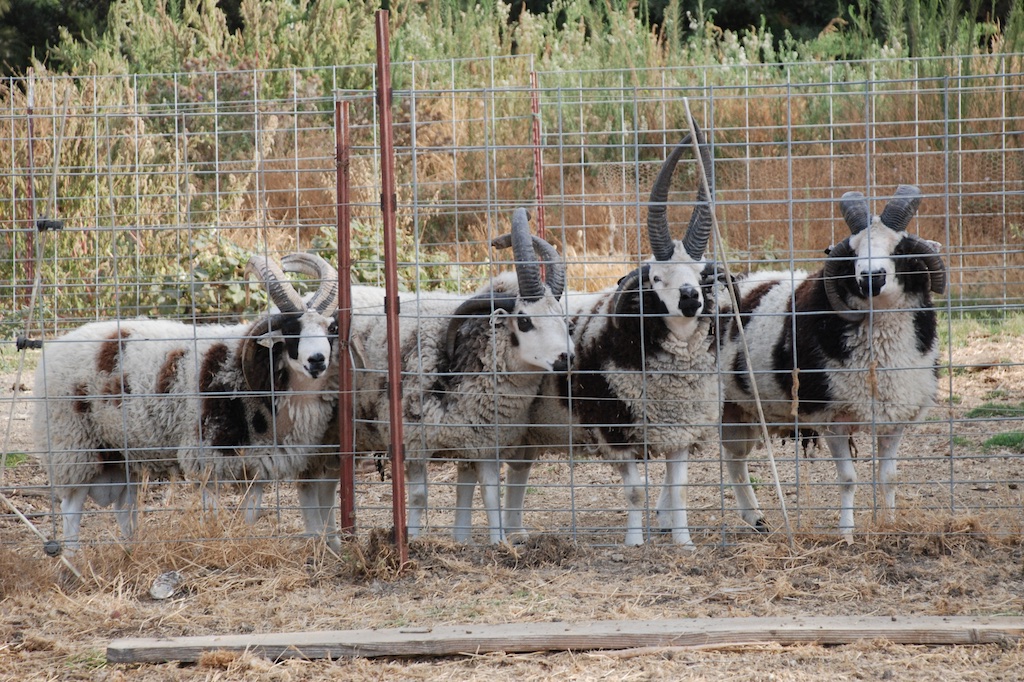 Here are the yearling and two-year old rams. Puddleduck Ringo, Meridian Crosby, Foley, and Alex. Foley is sold and will be picked up soon I hope. Before we went to Texas these rams switched places with...
Here are the yearling and two-year old rams. Puddleduck Ringo, Meridian Crosby, Foley, and Alex. Foley is sold and will be picked up soon I hope. Before we went to Texas these rams switched places with...
 ...Faulkner, the BFL ram, to give them more room and so that they couldn't keep getting tangled in the electric fence. It worked for awhile, but the ongoing saga is a subject for another blog post.
...Faulkner, the BFL ram, to give them more room and so that they couldn't keep getting tangled in the electric fence. It worked for awhile, but the ongoing saga is a subject for another blog post.
 Egrets looking over the pasture.
Egrets looking over the pasture.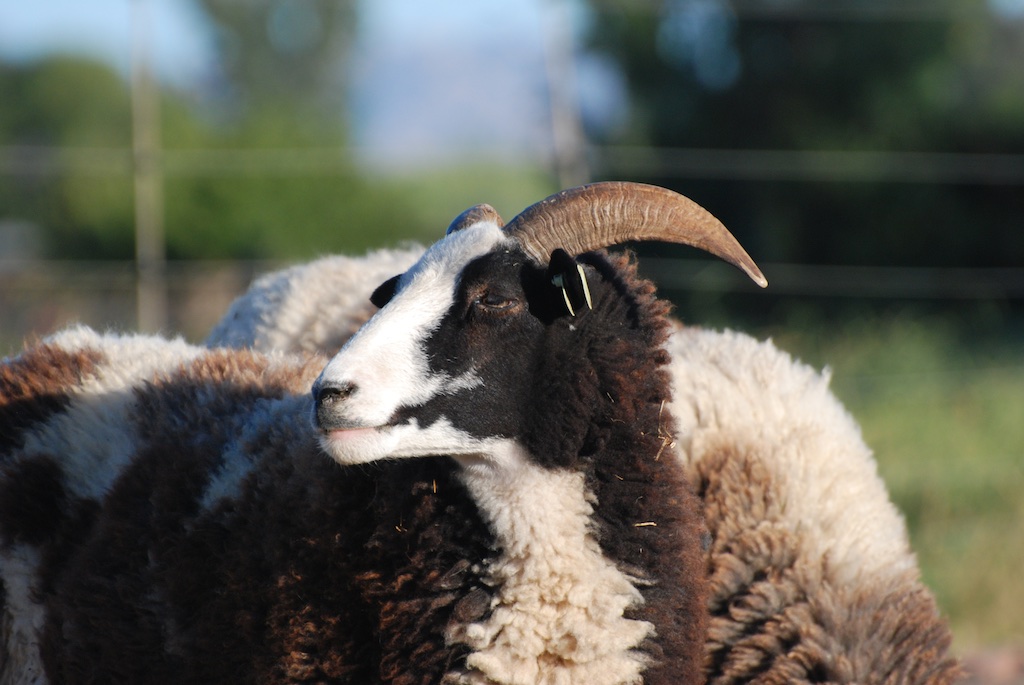 Hot LIps.
Hot LIps.
 Another ram issue. Notice how this horn (which has already been trimmed) is starting to irritate the skin on Alex's shoulders.
Another ram issue. Notice how this horn (which has already been trimmed) is starting to irritate the skin on Alex's shoulders.
 Another trim was required.
Another trim was required. Fresh water after cleaning the water trough. I so hope it rains this fall. I'm so tired of being dusty, hot, and dry. I don't know when I've looked forward to winter, but I sure am this year. I just hope it's not a disappointment.
Fresh water after cleaning the water trough. I so hope it rains this fall. I'm so tired of being dusty, hot, and dry. I don't know when I've looked forward to winter, but I sure am this year. I just hope it's not a disappointment. Ginny in her watching the road spot. She likes to chase trucks from her side of the fence.
Ginny in her watching the road spot. She likes to chase trucks from her side of the fence.
It's the time of year when I need to sell sheep. I want to get numbers down to 50 or so ewes by early October when breeding season begins. I have just separated the March ram lambs from the ewes and am now evaluating them as prospective breeding rams. It's hard to find that perfect ram. Unfortunately I don't have the space to keep these rams around for 6-8 more months to see how they look as they get a little older. That's too bad, because I'd rather be able to choose by seeing them with a little more maturity. (By the way the red in all these photos is marking crayon, not blood.) This ram (15045) has a fabulous horn spread--no chance of those horns growing into his face. He has lilac (gray-brown) markings and a good spotting pattern. But my notes say his fleece is so-so. I think I'll have to check again because everything else looks great.
This ram (15045) has a fabulous horn spread--no chance of those horns growing into his face. He has lilac (gray-brown) markings and a good spotting pattern. But my notes say his fleece is so-so. I think I'll have to check again because everything else looks great.  This ram's horns automatically disqualify him for remaining in my flock. They are fusing at the base and I don't like the "weepiness" that happens at the join between the horns--it is an area that attracts flies and that can lead to flystrike. Besides if they are already fused at this young age there is a good chance that the upper horns may cut off the blood supply to the lower ones which will weaken and be broken off.
This ram's horns automatically disqualify him for remaining in my flock. They are fusing at the base and I don't like the "weepiness" that happens at the join between the horns--it is an area that attracts flies and that can lead to flystrike. Besides if they are already fused at this young age there is a good chance that the upper horns may cut off the blood supply to the lower ones which will weaken and be broken off.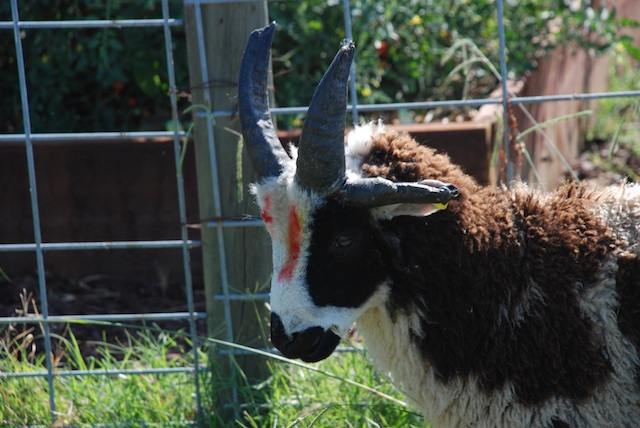 Here is another one with the same problem. No matter how much I might like his markings and fleece, I don't like the horns.
Here is another one with the same problem. No matter how much I might like his markings and fleece, I don't like the horns.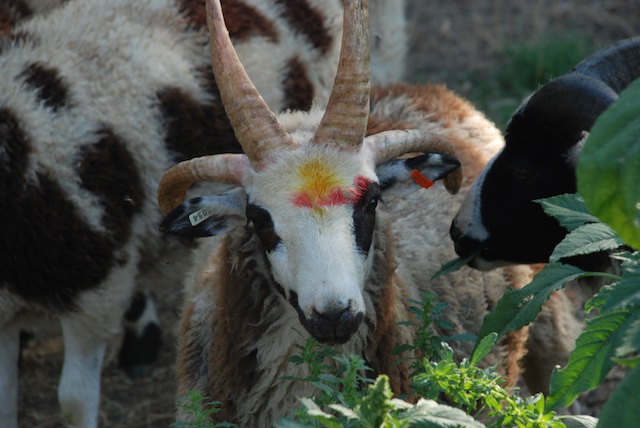 I had my eye on this ram (15054) because I like his wool but his horns are all white which makes him ineligible for registration...
I had my eye on this ram (15054) because I like his wool but his horns are all white which makes him ineligible for registration...
 ...and I aso discovered that he is missing something down below. Well, it's not completely missing, just about half size.
...and I aso discovered that he is missing something down below. Well, it's not completely missing, just about half size.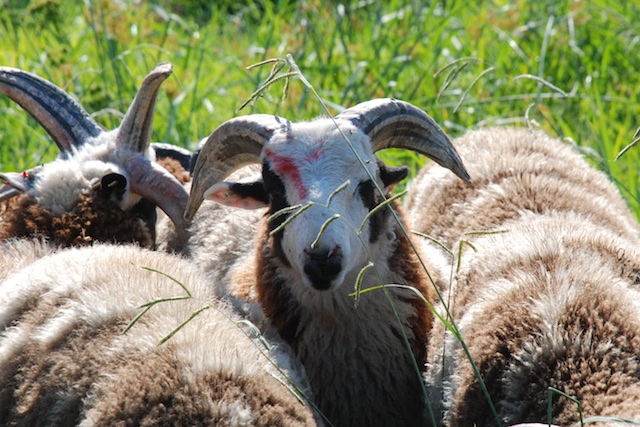 So here's a ram (15061) with nice horns and a decent fleece, but to register a ram he needs between 15% and 85% color.
So here's a ram (15061) with nice horns and a decent fleece, but to register a ram he needs between 15% and 85% color.
 Looking from this side he doesn't have that and he doesn't have much more color on the other side.
Looking from this side he doesn't have that and he doesn't have much more color on the other side. This ram (15062) has plenty of color, but his horns are much too narrow. They will grow right into his neck or face as they grow larger.
This ram (15062) has plenty of color, but his horns are much too narrow. They will grow right into his neck or face as they grow larger.
 Here is another with good color, but those horns are even more fused than the ones above. See that 5th horn on the right (the ram's left side)? People like to say that Jacob sheep can have 6 horns, but I have never seen one with 6 good horns. This is more my experience.
Here is another with good color, but those horns are even more fused than the ones above. See that 5th horn on the right (the ram's left side)? People like to say that Jacob sheep can have 6 horns, but I have never seen one with 6 good horns. This is more my experience. 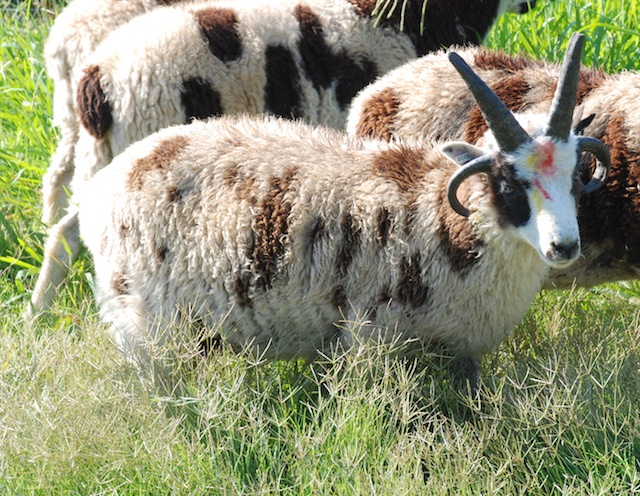 Here is a ram (15030) with decent horn spacing and nice fleece. There is a bit of a problem with the lower horns because at this time they look as though they are going to grow right into his jaw. Sometimes horns with a tight curl like that get broken off when the ram is still young and then they grow out OK. Whether or not his horns would turn out all right, upon closer inspection (hands-on) I discovered that this ram has freckled fleece. That makes a gorgeous handspinning fleece, but it is not appropriate for a breeding ram, and in fact, the JSBA Breed Standard states that "excessive freckling in the white wool of young animals" makes them ineligible for registration.
Here is a ram (15030) with decent horn spacing and nice fleece. There is a bit of a problem with the lower horns because at this time they look as though they are going to grow right into his jaw. Sometimes horns with a tight curl like that get broken off when the ram is still young and then they grow out OK. Whether or not his horns would turn out all right, upon closer inspection (hands-on) I discovered that this ram has freckled fleece. That makes a gorgeous handspinning fleece, but it is not appropriate for a breeding ram, and in fact, the JSBA Breed Standard states that "excessive freckling in the white wool of young animals" makes them ineligible for registration.
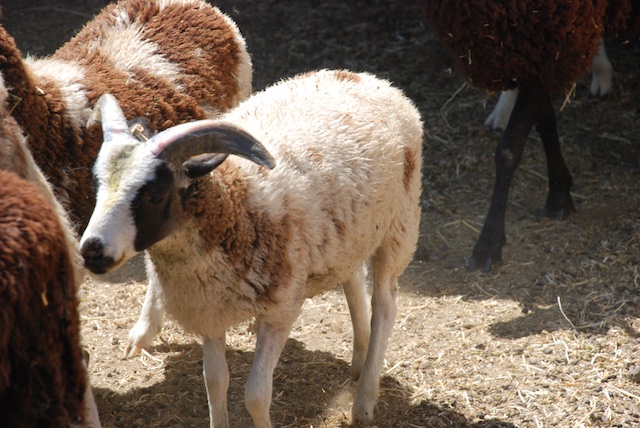 How about this ram (15070)? Widespread horns. Not a lot of color but it is over 15% and passable (I think). But I haven't really considered him because he is so much smaller than the other sheep. Granted, he is younger than many, but I don't want to choose one of the smaller rams in the lamb crop as my breeding ram. This is where being able to keep them awhile longer might aid in evaluation.
How about this ram (15070)? Widespread horns. Not a lot of color but it is over 15% and passable (I think). But I haven't really considered him because he is so much smaller than the other sheep. Granted, he is younger than many, but I don't want to choose one of the smaller rams in the lamb crop as my breeding ram. This is where being able to keep them awhile longer might aid in evaluation.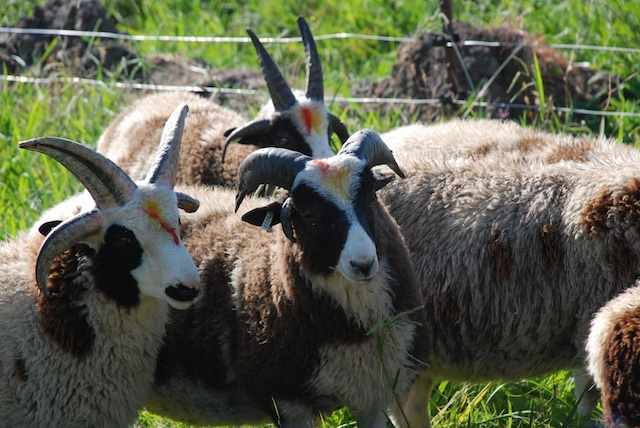 That 2-horn ram (15022) in the middle is a good sized lilac ram and we all had our eyes on him from the beginning. Unfortunately I think that his horn set is also narrow. This is another one that could benefit from time to find out how the horns actually do grow out.
That 2-horn ram (15022) in the middle is a good sized lilac ram and we all had our eyes on him from the beginning. Unfortunately I think that his horn set is also narrow. This is another one that could benefit from time to find out how the horns actually do grow out.
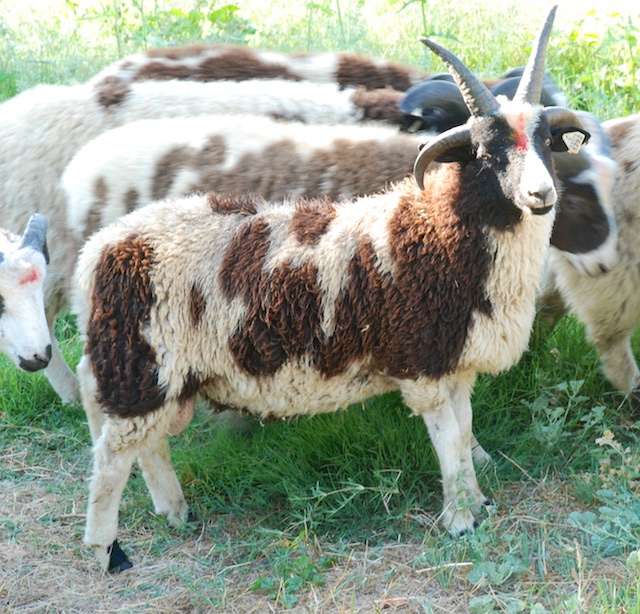 Here is a ram (15025) that might make a nice ram to keep.
Here is a ram (15025) that might make a nice ram to keep.  The two-horn ram in the middle of this photo is Nash, a lilac ram with nice horns and a beautiful fleece. He was Champion Ram at Black Sheep Gathering in June.
The two-horn ram in the middle of this photo is Nash, a lilac ram with nice horns and a beautiful fleece. He was Champion Ram at Black Sheep Gathering in June.
The rest of the ram lambs are shown at this link. However I haven't updated some of the listings with new photos. I will be removing some of the rams from that page now that I have evaluated them further.
I am grateful to my friends and family who are taking care of animals and the farm while I am gone. While driving through New Mexico on Tuesday I got a call and a text with this photo. That's a yearling ram, Foley, with his horns stuck in the 2-year old ram's upper horn.
That's a yearling ram, Foley, with his horns stuck in the 2-year old ram's upper horn.  My two friends had been trying to separate them but couldn't do it and called for advice. Not only did the rams continue to push against each other but the curved horn was holding the straight horns too tight. What to do? I gave the OK to cut the horn and told them where the wire saw was. But that's not an easy task. We finally thought of one more person to call--my future daughter-in-law's brother who lives in the area. Fortunately he was home, came over, and cut Ringo's horn.
My two friends had been trying to separate them but couldn't do it and called for advice. Not only did the rams continue to push against each other but the curved horn was holding the straight horns too tight. What to do? I gave the OK to cut the horn and told them where the wire saw was. But that's not an easy task. We finally thought of one more person to call--my future daughter-in-law's brother who lives in the area. Fortunately he was home, came over, and cut Ringo's horn.  That did the trick. Foley was fine but Ringo was a bit worn out--maybe from the angle of his head and neck for the whole time that they were stuck together and the fact that they had been struggling out in the hot sun. (He's fine now.)
That did the trick. Foley was fine but Ringo was a bit worn out--maybe from the angle of his head and neck for the whole time that they were stuck together and the fact that they had been struggling out in the hot sun. (He's fine now.) Lyle took the horn home as a souvenir.
Once again, thanks to everyone who is helping while I'm gone.
Lyle took the horn home as a souvenir.
Once again, thanks to everyone who is helping while I'm gone.
At Meridian Jacobs farm we raise Jacob sheep and sell locally grown wool fiber, yarn, and handwoven goods. We teach fiber classes and sell Ashford, Clemes & Clemes, and Schacht spinning and weaving equipment. We encourage farm visits with field trips and our unique Farm Club.
Search blog posts since 2019. If the search says it can’t find a post try putting in your search word a second time. I don’t know why but the second time it seems to work.
Search the entire website, including older blog posts.